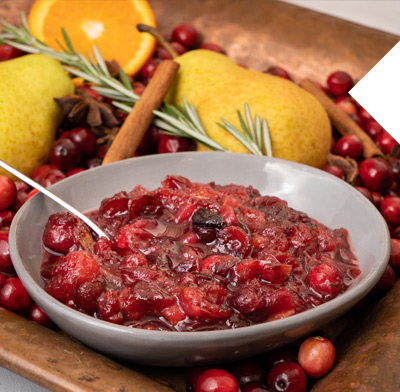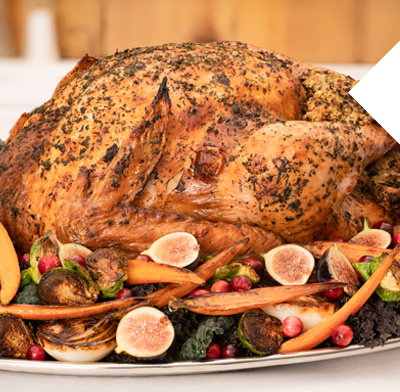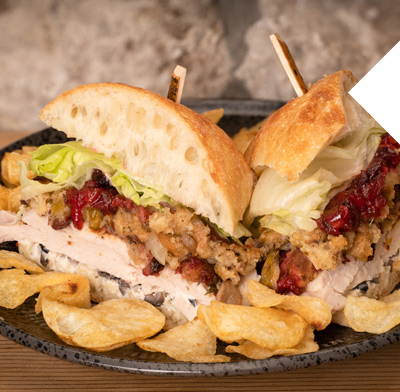Thanksgiving is quickly approaching, and while many of my chef friends will be preparing gourmet menus with salmon, duck, and pork, the Grand Bird is the main attraction at my table. Sadly, more than once we have all sat down to Thanksgiving dinner and found ourselves enjoying the sides a little more than we should and pouring a little extra gravy over our turkey because it was dry and lacked flavor. My search for the perfect roast turkey has introduced me to hundreds of recipes and dozens of different types of turkeys. After many years of roasting turkeys, I believe this recipe is the closest I have found to guarantee a tender, juicy, and flavorful turkey for your Thanksgiving guests every time.
Buying a turkey can be a confusing task with many options: fresh, frozen, free range, organic, Kosher, and more. Following the turkey-buying guidelines below will help ensure that your Thanksgiving guests will be raving about how moist and flavorful your turkey is from the first slice to leftover sandwiches the nest day.
I like to buy two 16- to 18-pound birds, one for roasting and the other I sacrifice for the stock, reserving the breast for the much-anticipated leftover sandwiches the next day. Sure, you can buy organic turkey stock in a box, but if you want your dinner to rise above the rest, invest the time in making your own stock. I consider the homemade turkey stock the soul of the Thanksgiving dinner and key to making the best stuffing and unforgettable gravy.
To prepare the turkey for the stock, remove the thigh and leg from the backbone by slicing a boning knife through the hip joint, then separate the thigh from the leg by slicing between the knee joint. Remove the backbones from the breast by slicing the rib bones from the cavity opening along the backbone and under the wings.
Repeat this process on both halves of the bird, being careful to leave the skin covering the breast intact and both breast halves connected. Remove the second and third wing pieces from the bird. Compress the two breast halves together and secure with butcher’s string, then stretch the two wing joints parallel to each other behind the breast. Season the entire bird with seasoning salt, wrap in food film, place in refrigerator until ready to roast. Using a butcher’s cleaver or large chef knife, break up the backbone into at least two pieces. Gather the wing tips, back bones, thighs, and legs for the stock recipe.
Thanksgiving is my favorite holiday meal and each year I get a little closer to the perfect roasted turkey. From buying a heritage turkey raised on an organic farm in Vermont, slaughtered on the Tuesday before Thanksgiving and shipped same day air, to grabbing a frozen bird at the local grocery store, my conclusion after roasting at least one hundred different birds is that a frozen 16- to 18-pound all-natural hen from a reputable local farm is the perfect choice. After it is brined at home and roasted using the recipe that follows, you will agree.
You’ll hear many opinions on what makes for “The best turkey” to buy, and there’s loads of opaque terms to consider. Here are some tips for what and how to buy:
All Natural: Only buy turkeys that use the term “Natural” on the label. Never buy a turkey that contains artificial flavor or flavoring, color ingredients, chemical preservatives, or any other artificial or synthetic ingredients.
Self-Basting Turkeys: Never buy self-basting turkeys. These birds are injected or marinated with a solution at the processing plant designed to make the turkey taste more flavorful. This bastingsolution contains fat, broth, water, flavor enhancers, and other substances. Don’t be fooled by these birds, they are not as good as the following recipe and once they have been brined they cannot be brined again. Brining your turkey at home with all-natural ingredients is very easy and will create a Thanksgiving main course that is moist and loaded with flavor.
Free Range or Free Roaming: This term is reserved for turkeys that are allowed free access to the outdoors over 51% of their lives. Many people feel this is a more ethical and less stressful method of turkey farming that results in a better tasting bird.
Kosher: This label can only be given to turkeys processed under the supervision of a Rabbi.
USDA Organic: The organic seal is reserved for turkeys raised on a farm that complies with the USDA Organic Standards and are processed in a facility that also meets certain standards. This certification does not guarantee that they will taste better or are raised free range.
A Frozen Turkey is Fresher than Fresh: Have you ever bought a fresh turkey from the market, unwrapped the packaging, and discover that your fresh bird is still partially frozen? You are not alone. The turkey industry is permitted to sell fresh birds that are 26 degrees Fahrenheit and above, which is 8 degrees below freezing. The problem with these seemingly fresh turkeys is that you have no idea how long they have been sitting in the grocery refrigerator in this semi-frozen state. This could be a problem on Thanksgiving morning when you discover an offsetting smell coming from your bird. Buy fresh salmon, but when it comes to turkeys buy frozen. This is the freshest bird you will buy as it was slaughtered and frozen on the same day and held at -20˚ below zero.
I remember my mom buying a Butterball frozen turkey and thawing it in the kitchen sink overnight. This method should be avoided for a couple of reasons; first, it thaws the meat too quickly, purging the natural juices out of the meat resulting in a dry turkey, and second, this can create a risk of foodborne illnesses by allowing the poultry to rest between 40˚ and 70˚for several hours, which is enough time to grow harmful bacteria. Instead, place your frozen turkey in the refrigerator 72 hours before Thanksgiving or on Monday morning.
Size does Matter: Unlike fryer chickens that are 100% female, turkey producers are looking for the fastest growing bird and the males tend to grow faster and larger than the hens. These turkeys may be labeled as “Tom Turkey” referring to a male bird ranging in size from 19 to 30 pounds. I prefer the hen, which tend to be the smaller birds and are typically under 18 pounds. Don’t worry about it being too small to feed your guests, a 16- to 18-pound bird can feed 12 to 14 people easily.
 |
Cranberry Chutney
Directions: Wash the cranberries and discard any that are soft or wrinkled. Combine the onion, pear, craisins, cranberry juice, orange juice, and honey in a 2-quart saucepan over medium-high heat. Bring to a boil and then reduce the heat to medium-low and simmer for 5 minutes. Add the cranberries, ginger, white pepper, cinnamon, thyme, and salt. Cook for 15 minutes, stirring occasionally, until the cranberries burst and the mixture thickens. Do not cook for more than 15 minutes as the pectin will start to break down and the sauce will not set as well. Remove from the heat and allow to cool for 5 minutes. Place in the refrigerator for at least 6 hours and up to overnight. |
 |
The Perfect Roast Turkey
For the Brine:
For the Aromatics:
For the Sage Butter:
Directions: After your turkey is thawed, remove it from packaging and place it in a clean sink. Remove the neck from the turkey cavity and the sack of liver and heart. Rinse the turkey with clean cold water to remove any remaining blood or fluid from the bird. Inspect your bird for any feathers that may have been missed. Now we are ready to brine the turkey. Brining meats is an old-world technique that replaces all of the turkey’s natural fluids (blood) with a sweet and salty flavor. Combine all brine ingredients, except ice water, in a stockpot, and bring to a boil. Stir to dissolve salt and sugar, then remove from heat, cool to room temperature, and refrigerate until thoroughly chilled. A few minutes before roasting, heat oven to 500°. Combine the apple and onion and cup of water in a microwave-safe dish and microwave on high for 5 minutes. Remove bird from brine and rinse inside and out with cold water. Discard brine. Place bird on roasting rack inside a wide, low pan and pat dry with paper towels. Add steeped aromatics to cavity along with rosemary, thyme, and sage. Tuck back wings and coat whole bird liberally with sage butter. Take special attention to place butter under breast skin. |
 |
Black Friday Turkey Sandwich
Directions: While making rolls for Thanksgiving dinner, I make a few larger size rolls for this important sandwich. Slice rolls in half and warm slightly. In a small bowl, combine sliced olives and mayonnaise. Spread 1 tablespoon of olive mayo on each side of bread. On the bottom roll, layer turkey evenly and season with salt and pepper. Compress the stuffing into a loaf shape with hands. Slice stuffing loaf into 8 thin slices and place on top of turkey. Heat gravy in microwave and spoon ½ tablespoon over the stuffing of each sandwich. Place crisp iceberg lettuce over stuffing. On top half of roll, spoon ½ tablespoon of gravy over the olive mayo. Places top half of roll on each sandwich and secure with two club-style toothpicks. Cut sandwich in half on the diagonal using a serrated knife, and serve with a side of cranberry sauce. |


